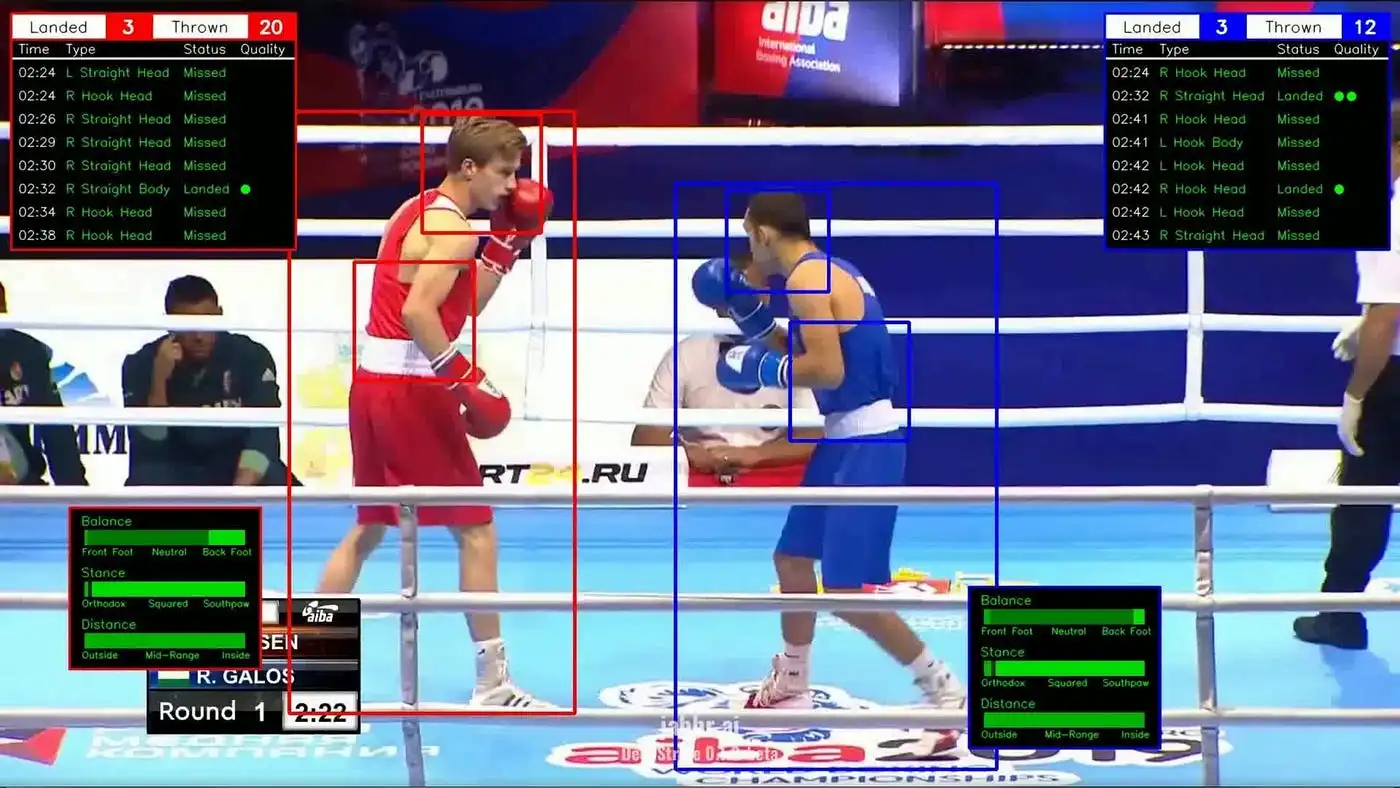From 2D Pixels To 3D Punches: Box Punch Detector Model With Computer Vision

Table of Contents
- Introduction
- Computer Vision in Punch Detection
- Data Collection and Preprocessing
- Data Annotation
- Model Selection and Architecture
- Model Training
- Model Testing
- Model Integration and Deployment
- Model Monitoring and Maintenance
- Challenges
- Conclusion
- Frequently Asked Questions
Introduction
The world of boxing is a fast-paced, highly skilled, and precise sport.
Each punch thrown reveals something about technique, strategy, and pure athleticism.
However, it can be difficult for the human eye to record and interpret these incredibly quick exchanges.
At this point, the powerful duo of AI and computer vision enters the picture and delivers a technological masterstroke straight into the center of the ring.
We'll be taking some serious theoretical jabs and delving into the intriguing field of computer vision-based box punch detector construction in this blog.
We intend to examine the data, refine our model, and potentially gain some valuable understanding in the process. Now, grab your boxing gloves and get ready to go into the virtual ring.
Computer vision in Punch Detection
![]()
This technology opens up a wealth of opportunities beyond basic punch detection:
· Performance Analysis - Picture coaches evaluating combat videos with computer vision to provide fighters immediate feedback on their tactics and style.
· Injury Prevention - Algorithms that examine movement patterns may be able to spot signs of exhaustion or incorrect form, which would help to avert injuries.
· Assistance for officials - Computer vision could offer objective data on punch landing and scoring to officials during close calls.
· Enhancement of Training - Punch detection-based virtual reality simulations may provide fighters with a new, secure approach to practice their techniques.
Data Collection and preprocessing
To learn various punches, a boxer need a varied training set; hence, our model must witness a range of throws from all directions and at all speeds.
Luckily, the internet is our training camp. We have the ability to access publicly accessible datasets of boxing contests, where we may record punches, crosses, hooks, and uppercuts in all their pixelated beauty.
For gathering data, there are several websites that one can visit, such as Kaggle,UC Irvine Machine Learning Repository,Dataset Search etc.
Still, that's not all! We can even record our own footage by shooting friends or neighborhood fighting matches to put our model's mettle to the test. Our model's ability to identify punches in the real world will improve with a greater diversity of data.
Data Annotation
![]()
· Draw rectangular boxes around the fists or forearms at the point of impact for each punch(Bounding Box).
· Make marks at particular body parts, like the elbows, wrists, shoulders, and hips.
· Record your punch trajectory and body stance and label the various punch types (uppercut, hook, cross, and jab).
Label the dataset by annotating images with bounding boxes or segmentation masks using tools like Labellerr.
Model Selection and Architecture
Model Selection
convolutional neural network (CNN) are the current leaders in image identification; they are very good at identifying patterns and spatial aspects in visual input. They are perfect for identifying punches in pictures or films.
Popular CNN architectures include InceptionV3, ResNet, and VGG16
Architecture Considerations
· Layer of input - Takes in photos or video frames, usually scaled to a common size.
· Convolutional layers - Utilize the input to extract features such as textures, forms, and edges.
· Layer pooling - Use max pooling frequently to reduce computational complexity and dimensionality.
· Fully linked layers - Flatten the features that have been extracted and arrive at conclusions (punch kind, location, etc.).
· Output layer - Categories identified punches (for example, jab, cross, hook, uppercut).
Model Training
· Training is the critical stage in which raw data is transformed into a skilled model. The model is fed data in batches, its prediction mistakes are evaluated, and internal parameters are changed using backpropagation.
· Hyperparameter optimisation fine-tunes the training process to ensure optimal learning, Much like a coach customises a fighter's training regimen and level of intensity.
Testing
Testing is the ultimate fight match in which our model must defend itself against a flurry of invisible blows. We will subject it to a wide range of fight footage, with varying lighting conditions, boxer styles, and viewpoints, in order to evaluate its accuracy, speed, and durability.
Integration and Deployment
Initially, it will be smoothly integrated into already-in-use boxing analytical software, such as performance monitoring or training systems. As coaches watch a fight, picture our model breaking out punches in real time and providing commentary and insights.
Deployment is calling next! We're going to make it available on large and small screens so that fighters, coaches, and even fans can experience the magic. Imagine referees using our blazing-fast punch detection to help them make sure every jab and cross lands fairly.
Monitoring and Maintenance
Monitoring
· Performance tracking - We'll keep an eye on the model's accuracy using actual data and spot any biases or dips. Consider monitoring punch detection rates in various boxer styles or settings.
· Error Analysis - We'll examine punches that were incorrectly identified in order to determine why the model faltered and how to enhance its algorithms or training set. Consider it akin to refining a fighter's skill by studying his or her missed blows.Drift
· Detection - Boxing techniques and camera technology change with time. We will keep an eye out for data drift to make sure the model remains flexible and current.
Maintenance
· Retraining - We'll periodically retrain the model using new data, adding novel punch techniques or making adjustments for shifting camera angles. Consider it as utilizing fresh training techniques to hone the fighter's abilities.
· Hyperparameter tuning - In order to maximize performance and take into account changing data landscapes, we'll continuously adjust hyper parameters like learning rate and batch size.
· Bug Fixes - We'll be on the lookout for and take care of any software flaws that could compromise the functionality or accuracy of the model.
Challenges
Even while computer vision has a lot of potential for boxing analysis, it's not just about neat footwork and uppercuts. Here is a summary of some of the difficulties it encounters in the ring:
· The Blurred Ballet - Boxing is a fast-paced sport, and it's not always simple to get clear shots. Rapid blows can become pixelated smudges, which complicates identification. Variations in lighting across several combat zones worsen the situation.
· Occlusion Enigma - Visualize a well-timed block or the body of a fighter blocking a punch. Occlusions like these have the potential to mislead models, resulting in misclassified or missed detection.
· The Style Stumble - Boxing styles are various, from the lightning-fast punches of a Floyd Mayweather to the massive hooks of a Mike Tyson. It can be difficult to train models to manage this stylistic diversity.
· The Angle Abyss - Camera angles play a key role. A head-on view may have trouble tracking footwork and body movements, while a side view might miss a well-hidden uppercut. Models must be flexible enough to accommodate different camera angles.
· The Bias Blindspot - Depending on variables like boxer skin tone or gender, training data may introduce biases that result in unfair or erroneous punch detection. When creating ethical and varied datasets, we must exercise caution.
· The Ethical Elbow - Moral considerations are more important than truth. Concerns about potential data misuse or an over-reliance on technology for judgement call for cautious consideration.
However, these obstacles are not insurmountable. Computer vision is a field that is always changing, and new solutions are being created:
· Advanced algorithms - Convolutional neural networks are growing better at handling blur, occlusion, and various styles.
· 3D data analysis - Resolving occlusion problems can be aided by gathering depth information.
· Multi-camera setups - Combining images from different angles can create a more complete picture.
· Fairness-aware training - Techniques are being developed to eliminate bias in datasets and algorithms.
Conclusion
Computer vision enters the boxing arena with a tremendous punch of punch detection. Even while issues like bias and blur still exist, a better future is being shaped by advanced algorithms and moral considerations.
Imagine improved training, more fair judgement, and a more in-depth grasp of the sport, all pixel by pixel. It's not only about technology; it's about revolutionizing boxing one punch at a time. With the potential to take computer vision to new heights, it is time to start the next round.
Frequently Asked Questions
Q1. How is computer vision used in sports?
Picture every move, trick, and pass being painstakingly recorded and then turned into a symphony of information that reveals underlying trends and patterns.
Coaches, commentators, and even fans gain game-changing insights from this greater understanding.
Computer vision unlocks the language of movement, changing the way we observe and value the beautiful game—from figuring out an MVP's secret sauce to anticipating an opponent's next play.
Q2. What is the Computerised vision system in sport?
Modern umpires consider the "Hawk-Eye" to be an infallible third eye, as human eyes may become unreliable under duress.
By monitoring the ball's every spin and swerve, this computer vision system creates a digital oracle that will definitively answer the age-old question, "In or out?!" From the elegant curves of a tennis serve to the quick flick of a cricket delivery, Hawk-Eye cuts through doubt to guarantee fair play and eliminate any possibility of disagreement.
With sports being a high-stakes environment where split-second choices are crucial, our technology makes sure that justice always wins out.

Simplify Your Data Annotation Workflow With Proven Strategies
.png)


